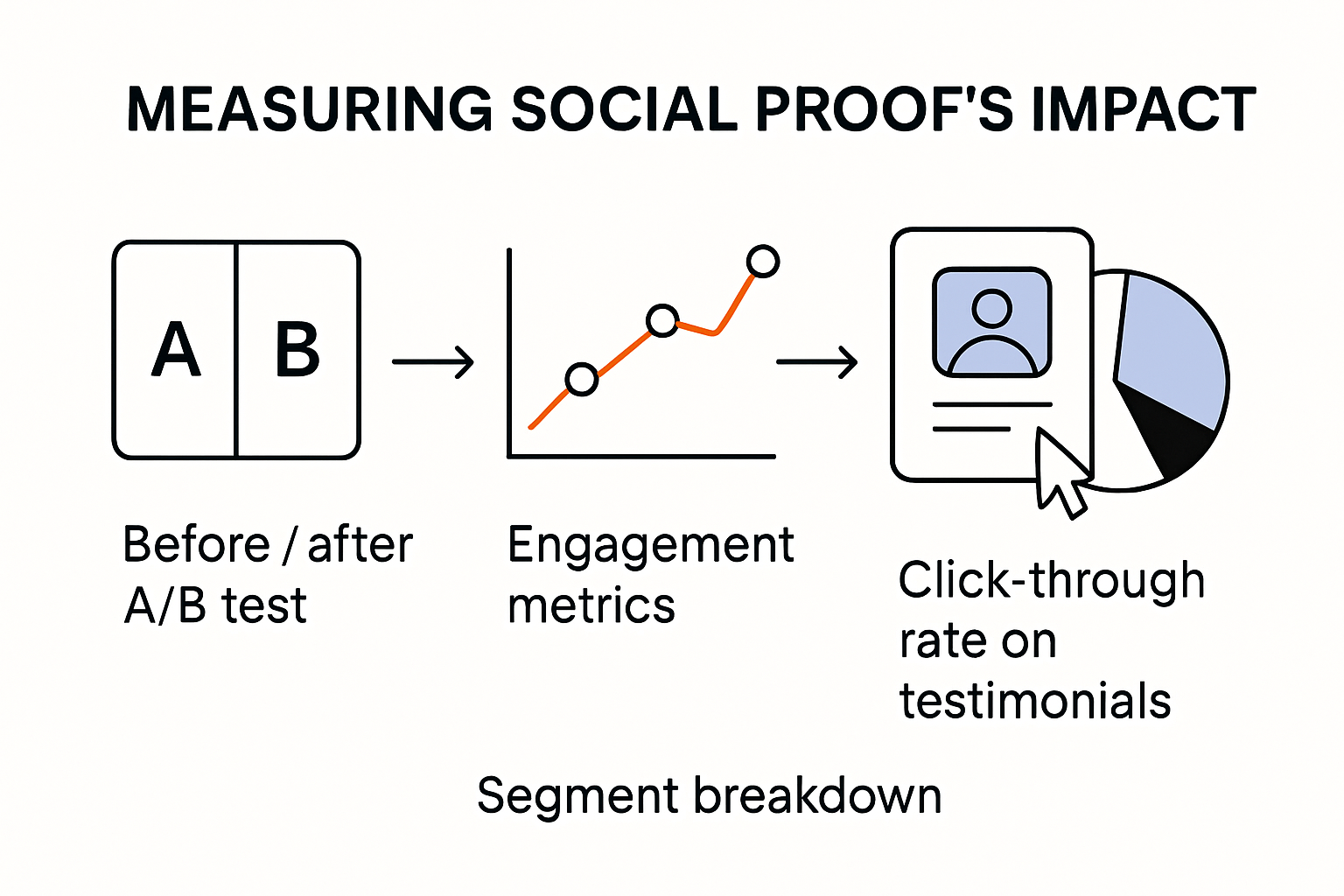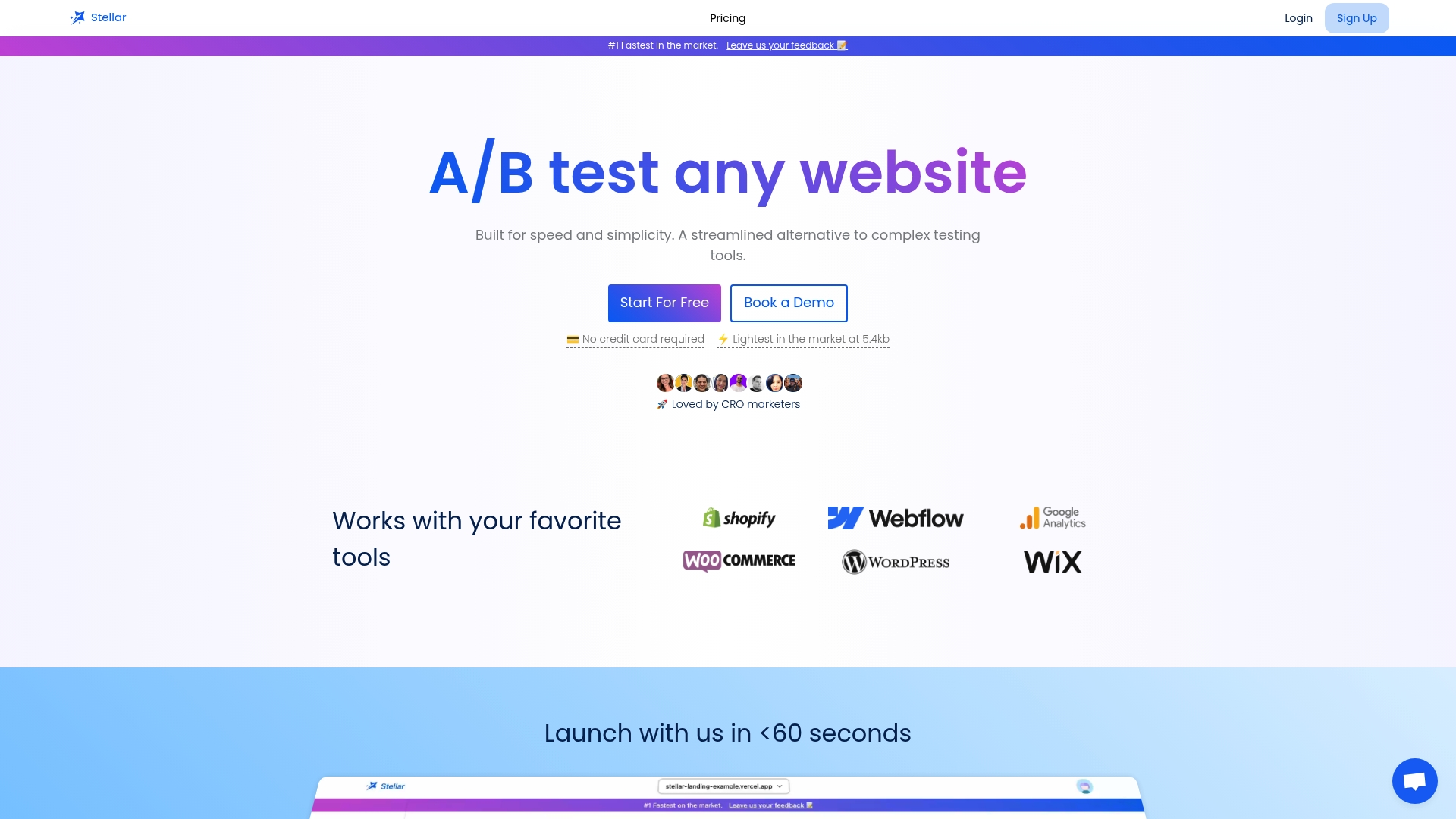
How to Use Social Proof on Landing Pages for Higher Conversions in 2025

Everyone wants their landing pages to convert, but most overlook one of the most powerful conversion triggers out there. You might think slick design or catchy headlines are what build trust and drive clicks. Actually, what really moves the needle is social proof. Landing pages with strong social proof can see conversion lifts of up to 34 percent. The trick is not just in adding testimonials—it's knowing exactly how and where to use them for maximum impact.
Table of Contents
- Why Social Proof Works On Landing Pages
- Types Of Social Proof That Boost Conversions
- Best Practices For Placing Social Proof Elements
- Measuring The Impact Of Social Proof On Results
Quick Summary
| Takeaway | Explanation |
|---|---|
| Leverage authentic customer testimonials. | Genuine testimonials provide real-world validation and build trust among potential customers. |
| Utilize quantitative indicators effectively. | Show metrics like user counts and ratings to enhance perceived value and foster confidence in purchasing decisions. |
| Position social proof strategically. | Place testimonials near conversion points, enhancing visibility at key moments in the user journey. |
| Customize social proof for specific audiences. | Tailor testimonials and endorsements to resonate with different user demographics and pain points |
| Continuously measure and refine social proof impact. | Regularly analyze engagement metrics and test elements to optimize effectiveness on landing pages. |
Why Social Proof Works on Landing Pages
Psychological principles drive the effectiveness of social proof on landing pages, transforming how potential customers perceive and interact with digital marketing content. Understanding the underlying mechanisms reveals why this strategy has become a critical conversion optimization technique.
The Psychological Foundation of Social Proof
Humans are inherently social creatures who seek validation from their peers before making decisions. Research by Robert Cialdini reveals that people naturally look to others' actions when navigating uncertain situations, a psychological phenomenon that directly impacts consumer behavior. When visitors encounter social proof elements on a landing page, they unconsciously interpret these signals as low-risk endorsements.
The power of social proof stems from our deep-rooted evolutionary instinct to follow group behaviors. A study by Bakshy et al. demonstrated that social cues significantly increase consumer engagement, with advertisements featuring peer affiliations generating higher click-through rates. This research underscores the profound impact of social validation in digital marketing contexts.
Cognitive Triggers That Enhance Conversion Rates
Social proof works by activating multiple cognitive triggers simultaneously. First, it reduces perceived risk by showcasing successful experiences from other users. Potential customers feel more confident when they see tangible evidence that others have already benefited from a product or service. Second, it creates a sense of trust through third-party validation, which is far more powerful than direct brand messaging.
The neurological response to social proof is fascinating. When individuals see positive testimonials, user reviews, or case studies, their brains release oxytocin - a hormone associated with trust and bonding. This neurochemical reaction makes potential customers more receptive to marketing messages and more likely to take desired actions on landing pages.
Strategic Implementation for Maximum Impact
Effective social proof goes beyond simply displaying random testimonials. The most compelling social proof elements are specific, authentic, and directly relevant to the target audience's pain points. This means showcasing results from users who closely resemble potential customers, using real names, specific outcomes, and quantifiable achievements.
Visitors want to see genuine, verifiable social proof that speaks directly to their needs. A generic statement like "Great product" carries minimal weight compared to a detailed testimonial that explains exactly how a solution solved a specific problem. The more precise and relatable the social proof, the more powerful its psychological impact on landing page conversions.
By understanding and strategically leveraging these psychological principles, marketers can transform landing pages from static information displays into compelling conversion engines that speak directly to potential customers' deepest decision-making motivations.
Types of Social Proof That Boost Conversions
Converting website visitors into customers requires strategic use of diverse social proof elements that resonate with potential buyers. Not all social proof is created equal, and understanding the nuanced effectiveness of different types can dramatically improve landing page performance.
Customer Testimonials and Reviews
Research from academic studies confirms that customer reviews and testimonials remain the most powerful form of social proof. These authentic, user-generated endorsements provide potential customers with real-world validation of a product or service. The most compelling testimonials go beyond generic praise, offering specific details about how a solution solved a particular problem.
Verified customer reviews carry significant weight because they represent unbiased, genuine experiences. Potential buyers are more likely to trust detailed accounts from people who have actually used a product, especially when these testimonials include specific outcomes, challenges overcome, and measurable results. Including photographs or video testimonials can further enhance credibility by adding a human element to the social proof.
Quantitative Social Proof Indicators
Research on online advertising effectiveness demonstrates that numerical indicators of popularity can significantly boost conversion rates. These quantitative social proof elements include:
- User Count: Displaying the total number of users or customers
- Usage Statistics: Showing how many times a product has been used or purchased
- Ratings: Presenting average user ratings or total number of reviews
- Social Media Followers: Highlighting the size of a brand's social community
These numerical indicators work by creating a sense of collective validation. When potential customers see that many others have already chosen a product or service, they feel more confident in their decision to do the same. The psychological principle of social validation suggests that people are more likely to take action when they believe others have already done so successfully.
Expert and Influential Endorsements
While customer testimonials remain most effective, expert and influential endorsements can provide an additional layer of credibility. This type of social proof is particularly powerful when the endorsement comes from a recognized authority in the relevant field. Key considerations include:
- Selecting experts with genuine expertise in the specific domain
- Ensuring the endorsement feels authentic and not overly scripted
- Matching the expert's credibility to the target audience's expectations
The most impactful expert endorsements go beyond simple statements of approval. They should provide meaningful insights into how a product or service solves specific problems or delivers unique value. A well-crafted expert endorsement can bridge the gap between customer curiosity and confident decision-making.
By carefully combining these different types of social proof, marketers can create a compelling narrative that addresses potential customers' concerns, builds trust, and ultimately drives higher conversion rates on landing pages.
To help you quickly compare the main types of social proof discussed in this article and their unique strengths, here’s a summary table outlining each type and its key characteristics:
| Type of Social Proof | Key Characteristics | Most Effective When |
|---|---|---|
| Customer Testimonials & Reviews | Authentic, detailed, relatable; includes specific outcomes and photos | Targeting trust and credibility |
| Quantitative Indicators | Numerical data (user count, ratings, usage stats, followers) | Demonstrating popularity/validation |
| Expert & Influential Endorsements | Statements from recognized authorities with relevant expertise | Building authority and confidence |
Best Practices for Placing Social Proof Elements
Strategic placement of social proof elements can dramatically enhance their effectiveness on landing pages. The location, visibility, and context of these trust signals significantly impact their ability to convert potential customers.
Strategic Positioning for Maximum Impact
The Nielsen Norman Group emphasizes the critical importance of positioning social proof elements where they naturally guide user decision-making. Typically, this means placing social proof near key conversion points such as call-to-action buttons, pricing sections, and primary value propositions.
Visitors typically scan landing pages in predictable patterns, making certain locations more powerful for social proof deployment. The top third of the page and immediately adjacent to primary conversion elements tend to generate the most significant impact. This strategic positioning ensures that potential customers encounter trust signals at the precise moment they are evaluating whether to take action.
Visibility and Hierarchy of Social Proof
CXL's research reveals that not all social proof elements are created equal. The most effective landing pages create a clear hierarchy of social proof, prioritizing the most compelling and relevant testimonials and endorsements.
Consider creating a visual hierarchy that draws attention to the most powerful social proof elements:
- Prominent Customer Testimonials: Feature detailed, specific testimonials with client names and photos
- Quantitative Indicators: Highlight numerical proof like total users or success rates
- Expert Endorsements: Position authoritative quotes in visible locations
The key is to make these elements visually distinct without overwhelming the page's primary message. Use design techniques like contrasting colors, strategic white space, and subtle animations to draw attention to social proof without creating visual noise.
Context and Relevance Optimization
Social proof becomes exponentially more powerful when it speaks directly to specific user segments and their unique challenges. This means tailoring social proof to different audience personas, industries, or use cases. A technology professional will respond differently to a testimonial compared to a small business owner, even if the underlying product remains the same.
Implement dynamic social proof elements that can be customized based on user attributes such as:
- Visitor's industry
- Company size
- Specific pain points
- Geographic location
By creating contextually relevant social proof, you transform these elements from generic endorsements into personalized trust signals that directly address potential customers' specific concerns and aspirations.
The most successful landing pages treat social proof as a strategic communication tool, not just a collection of random testimonials. They carefully craft a narrative of trust, credibility, and demonstrated value that guides visitors smoothly toward conversion.
Measuring the Impact of Social Proof on Results
Effective measurement of social proof's impact requires a comprehensive approach that goes beyond surface-level metrics. Marketers must develop sophisticated strategies to quantify how social proof elements influence customer behavior and conversion rates.

Key Performance Indicators for Social Proof
Research from Marketing Science & Inspirations reveals that tracking social proof effectiveness involves multiple critical metrics. The most important indicators include conversion rate changes, engagement duration, and specific interaction rates with social proof elements.
Primary metrics to track include:
- Conversion Rate: Percentage of visitors who complete the desired action
- Engagement Time: Duration visitors spend interacting with social proof elements
- Click-through Rates: Interactions with testimonials and social proof sections
- Bounce Rate: Changes in page exit rates when social proof is implemented
These metrics provide a holistic view of how social proof influences user behavior. By carefully analyzing these indicators, marketers can understand the nuanced ways social proof impacts decision-making processes.
Below is a table summarizing the key performance indicators (KPIs) to track when measuring the impact of social proof on landing page results, as highlighted in the article:
| Key Metric | What It Measures | Why It Matters |
|---|---|---|
| Conversion Rate | % of visitors completing desired action | Direct indicator of landing page success |
| Engagement Time | Time spent with social proof elements | Shows level of interest and interaction |
| Click-through Rate | Interactions with testimonials/social proof | Reveals which elements drive action |
| Bounce Rate | % of users exiting after viewing the page | Assesses if social proof retains or loses visitors |
Experimental Approaches to Validation
A field experiment on social advertising demonstrated the importance of rigorous testing methodologies. The most effective approach involves A/B testing different social proof implementations to understand their specific impact. This means creating multiple versions of landing pages with variations in social proof placement, type, and presentation.
Key experimental strategies include:
- Isolating individual social proof elements
- Comparing different types of testimonials
- Testing placement and visibility of social proof
- Analyzing audience-specific responses
The experimental approach allows marketers to move beyond generic assumptions and develop data-driven social proof strategies tailored to their specific audience.
Audience-Specific Impact Analysis
Research in consumer behavior highlights the critical importance of understanding how different audience segments respond to social proof. What works for one demographic may completely fail for another, making granular analysis essential.
Consider segmenting your analysis by:
- Age groups
- Industry sectors
- Professional roles
- Purchasing behaviors
This nuanced approach reveals subtle differences in how various audience segments perceive and respond to social proof. Some groups may be more influenced by numerical indicators, while others respond better to detailed testimonials or expert endorsements.
Ultimately, measuring social proof is an ongoing process of continuous testing, analysis, and refinement. Successful marketers treat social proof as a dynamic element that requires constant optimization, using data-driven insights to create more compelling and convincing landing page experiences.

Frequently Asked Questions
What is social proof and why is it important for landing pages?
Social proof is a psychological phenomenon where people look to the actions and opinions of others to make decisions. It's important for landing pages because it helps build trust and credibility, leading to higher conversion rates.
How can customer testimonials enhance conversion rates on landing pages?
Customer testimonials provide authentic validation about a product or service. When potential customers read detailed, relatable testimonials, they feel more confident in their purchasing decisions, which can increase conversion rates by up to 34%.
What are quantitative social proof indicators and how do they affect purchase decisions?
Quantitative social proof indicators include metrics such as user count, ratings, and usage statistics. These indicators create a sense of popularity and validation, encouraging potential customers to make purchases based on the perceived approval of others.
How should social proof elements be strategically placed on landing pages?
Social proof elements should be placed near key conversion points, such as call-to-action buttons and pricing sections. Placing them in the top third of the page or near important value propositions enhances their visibility and impact during the decision-making process.
Turn Social Proof Into Real Conversions With Effortless A/B Testing
You have learned how strategic social proof boosts landing page conversion rates. But even with powerful testimonials and validation, the real challenge is pinpointing exactly what works for your unique audience. Too often, marketers struggle to run A/B tests that are quick, actionable, and data-driven—especially when every second counts and you cannot afford performance slowdowns. That is where Stellar comes in. Our solution addresses pain points like slow experimentation, lack of technical resources, and clunky analytics, making sure your landing pages convert at their highest potential.

Ready to see which social proof resonates best with your visitors? Try Stellar's visual editor and advanced goal tracking to run tests in minutes. Start for free today and find out how easy it is to boost your landing page conversions with real-time analytics and a lightweight, no-code platform. Take the next step at https://gostellar.app and let every visitor become a believer.
Recommended
Published: 8/8/2025
